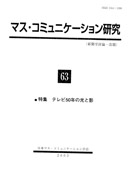63 巻
選択された号の論文の22件中1~22を表示しています
- |<
- <
- 1
- >
- >|
■特集 テレビ50年の光と影
-
原稿種別: 本文
2003 年 63 巻 p. 2-3
発行日: 2003/07/31
公開日: 2017/10/06
PDF形式でダウンロード (126K) -
原稿種別: 本文
2003 年 63 巻 p. 4-21
発行日: 2003/07/31
公開日: 2017/10/06
PDF形式でダウンロード (1157K) -
原稿種別: 本文
2003 年 63 巻 p. 22-39
発行日: 2003/07/31
公開日: 2017/10/06
PDF形式でダウンロード (1391K) -
原稿種別: 本文
2003 年 63 巻 p. 40-53
発行日: 2003/07/31
公開日: 2017/10/06
PDF形式でダウンロード (1109K) -
原稿種別: 本文
2003 年 63 巻 p. 54-71
発行日: 2003/07/31
公開日: 2017/10/06
PDF形式でダウンロード (1265K) -
原稿種別: 本文
2003 年 63 巻 p. 72-97
発行日: 2003/07/31
公開日: 2017/10/06
PDF形式でダウンロード (2156K)
■論文
-
原稿種別: 本文
2003 年 63 巻 p. 98-111
発行日: 2003/07/31
公開日: 2017/10/06
PDF形式でダウンロード (1121K) -
原稿種別: 本文
2003 年 63 巻 p. 112-129
発行日: 2003/07/31
公開日: 2017/10/06
PDF形式でダウンロード (1330K) -
原稿種別: 本文
2003 年 63 巻 p. 130-143
発行日: 2003/07/31
公開日: 2017/10/06
PDF形式でダウンロード (1118K) -
原稿種別: 本文
2003 年 63 巻 p. 144-161
発行日: 2003/07/31
公開日: 2017/10/06
PDF形式でダウンロード (1539K)
■2002年度秋季研究発表会 ワークショップ報告
-
原稿種別: 本文
2003 年 63 巻 p. 162-163
発行日: 2003/07/31
公開日: 2017/10/06
PDF形式でダウンロード (208K) -
原稿種別: 本文
2003 年 63 巻 p. 163-164
発行日: 2003/07/31
公開日: 2017/10/06
PDF形式でダウンロード (214K) -
原稿種別: 本文
2003 年 63 巻 p. 164-166
発行日: 2003/07/31
公開日: 2017/10/06
PDF形式でダウンロード (299K) -
原稿種別: 本文
2003 年 63 巻 p. 166-167
発行日: 2003/07/31
公開日: 2017/10/06
PDF形式でダウンロード (211K) -
原稿種別: 本文
2003 年 63 巻 p. 168-169
発行日: 2003/07/31
公開日: 2017/10/06
PDF形式でダウンロード (190K) -
原稿種別: 本文
2003 年 63 巻 p. 169-170
発行日: 2003/07/31
公開日: 2017/10/06
PDF形式でダウンロード (199K) -
原稿種別: 本文
2003 年 63 巻 p. 170-172
発行日: 2003/07/31
公開日: 2017/10/06
PDF形式でダウンロード (290K) -
原稿種別: 本文
2003 年 63 巻 p. 172-174
発行日: 2003/07/31
公開日: 2017/10/06
PDF形式でダウンロード (292K) -
原稿種別: 本文
2003 年 63 巻 p. 174-175
発行日: 2003/07/31
公開日: 2017/10/06
PDF形式でダウンロード (227K)
■研究会の記録(2002年11月~2003年3月)
-
原稿種別: 本文
2003 年 63 巻 p. 176-177
発行日: 2003/07/31
公開日: 2017/10/06
PDF形式でダウンロード (207K) -
原稿種別: 本文
2003 年 63 巻 p. 177-178
発行日: 2003/07/31
公開日: 2017/10/06
PDF形式でダウンロード (187K)
■日本マス・コミュニケーション学会会員研究文献目録
-
原稿種別: 付録等
2003 年 63 巻 p. 200-179
発行日: 2003/07/31
公開日: 2017/10/06
PDF形式でダウンロード (972K)
- |<
- <
- 1
- >
- >|
